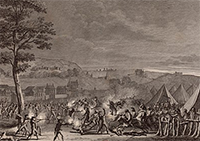The French Directory
Part 2: More Rebellions
Free to conduct its first elections under the new Constitution, the Convention carried out its directive. Of the 750 members of the new houses, 384 were members of the Convention. The Council of Ancients chose the first members of the Directory on October 31. 
In April 1796, a number of Jacobins led by Françcois "Gracchus" Babeuf, a publisher and former priest turned agitator, put in motion plans to overthrow the new government and restore the government mandated by the previous blueprint, the Constitution of 1793. The Directory had no trouble preventing the coup, dubbed the Conspiracy of the Equals, from taking place and systematically rounded up Babeuf and the other ringleaders, making an example of Babeuf by sending him to the guillotine. The war continued, with France fighting against Austria and Great Britain. The Director in charge of military affairs, Lazare Carnot, oversaw a three-pronged attack against Austria. The forces under two generals, Jean-Baptiste Jourdan and Jean Victor Moreau, marched against Austria forces in the north but met with defeat. The Army of Italy, under Bonaparte, had sustained success. The Directory also convinced Spain to come into the war as an ally of France, opposing Great Britain. The Directory engineered another governmental overthrow in September 1797, in order to counter a resurgence of royalist strength. The elections of that year had delivered 87 more royalists into the legislature than the year before, and republicans feared that the next election would result in even more. Among those that the coup plotters wanted to get rid of was Jean-Charles Pichegru, the President of the Council of Five Hundred. In what is known as the Coup of 18 Frucitor, Year V, a cadre of Directors joined with the military to declare martial law in Paris and then arrested Pichegru and other leading royalists, including two members of the Directory. In all, soldiers (including a contingent sent from the field by Bonaparte) arrested 214 deputies and sent many of those into exile. This coup stood until the next year's elections, in which radical elements made gains once again. 
After his success in Italy, Bonaparte found himself in demand elsewhere. Recalled to Paris, he began planning an invasion of Britain. That never materialized, mainly because he was of the firm opinion that such a plan could never work so long as British forces controlled the high seas. Instead, he led troops against British interests in the Middle East. Bonaparte and 35,000 soldiers, aboard 200 ships, sailed for Egypt. They captured Malta, then Alexandria, and then, on July 21, 1798, defeated the Mameluks in the Battle of the Pyramids. All of that seemed for naught on August 1, when the British fleet under Admiral Horatio Nelson savaged the French fleet at the Battle of the Nile. France had yet another enemy during the War of the First Coalition, the United States. The two countries had signed the Treaty of Alliance in 1778, bringing France into the American Revolutionary War on the side of the U.S. and against Britain. Now that France was again fighting Britain, France expected the U.S. to honor its commitments under the Treaty of Alliance. The U.S. instead ratified an agreement with Britain, the Jay Treaty, in 1795, and France began to seize American merchant ships. An attempt at negotiation resulted in the XYZ Affair, whereby three American agents were humiliated by the French foreign minister, Talleyrand, who demanded bribes before even starting negotiations. President John Adams authorized funds to bulk up the American Navy, but the two countries never officially went to war. Next page > The End of the Revolution > Page 1, 2, 3 |
|
Social Studies for Kids
copyright 2002–2025
David White



 A rebellion of another kind occurred in October 1795, just days after the new Constitution was declared in force, as a large number of royalists took up arms against the republican government and aimed to set up their own, dedicated to the return of a constitutional monarchy. The plan was to march down both banks of the Seine and converge on the Tuileries Palace, where the Convention was meeting. The insurgents never got to the palace. A group of soldiers led by Gen. Joachim Murat at the Sablons and a young
A rebellion of another kind occurred in October 1795, just days after the new Constitution was declared in force, as a large number of royalists took up arms against the republican government and aimed to set up their own, dedicated to the return of a constitutional monarchy. The plan was to march down both banks of the Seine and converge on the Tuileries Palace, where the Convention was meeting. The insurgents never got to the palace. A group of soldiers led by Gen. Joachim Murat at the Sablons and a young 
